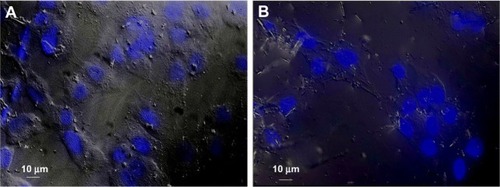Figures & data
Figure 1 Structural and morphological characterization of Bi2O3 NPs, the crystalline habit, and the idealization of the hydroxyl ions and water molecules interactions with the −120 surface plane.
Notes: (A) Bi2O3 NPs X-ray diffraction pattern. This sample was synthesized in water, as described in the Materials and methods section. In this case, the observed peaks match with the α-phase (monoclinic) of Bi2O3. (B) TEM image of the Bi2O3 NPs clearly shows the needle shape exhibited by these nanoclusters. (C) This model shows the crystal structure of a representative particle, with the respective exposed planes. (D) The images shows a (−120) plane sketch, in particular, the enhanced interaction of bismuth atoms with hydroxyl ions and water molecules.
Abbreviations: Bi2O3, bismuth oxide; NP, nanoparticle; TEM, transmission electron microscope.
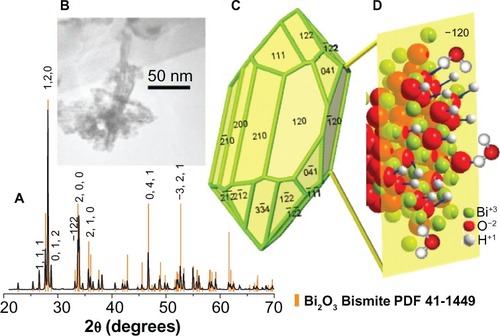
Figure 2 Antifungal activity of bismuth oxide nanoparticles against Candida albicans growth.
Notes: The y axis shows the optical density units of C. albicans growth. C. albicans culture without inhibitor was used as the growth control, whereas chlorhexidine 2%, terbinafine 1%, Bi2O3 (bulk material), and Bi(NO3)3 · 5H2O were used as positive inhibition controls. For these experiments, we used a concentration of 2 mM of the respective bismuth species.
Abbreviations: Bi2O3, bismuth oxide; Bi(NO3)3 · 5H2O, bismuth nitrate pentahy-drate; NP, nanoparticle.
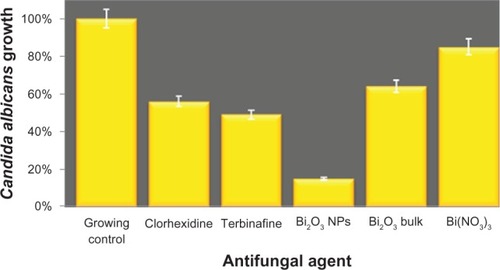
Figure 3 MIC of bismuth oxide nanoparticles against Candida albicans growth.
Notes: The y axis shows the optical density units of C. albicans growth; the x axis shows the different concentrations of Bi2O NPs analyzed. C. albicans culture without inhibitor was used as a growth control. Experiments were carried out three times and each time by triplicate. Average results were obtained from the three independent experiments.
Abbreviations: Bi2O3, bismuth oxide; MIC, minimal inhibitory concentration; NP, nanoparticle.
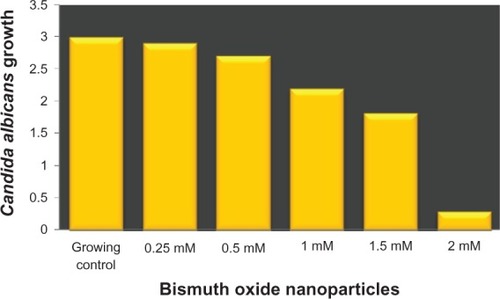
Figure 4 Inhibition of Candida albicans biofilm detected by fluorescence microscopy, after 24 hours. As a growth control, C. albicans was added to culture media; chlorhexidine 2% and terbinafine 1% were employed as positive inhibition controls. In these experiments, we used a concentration of 2 mM Bi2O3 NPs. (A) growth control; (B) chlorhexidine; (C) terbinafine; and (D) Bi2O3 NPs.
Note: The bar indicates 1 μm.
Abbreviations: Bi2O3, bismuth oxide; NP, nanoparticle.
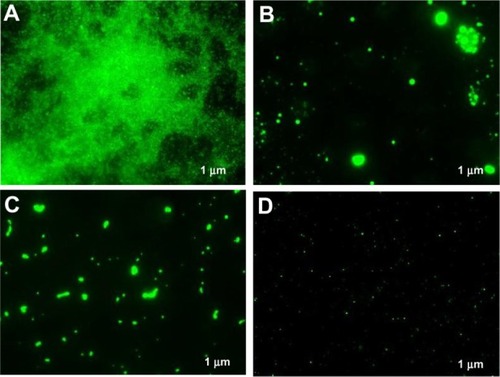
Figure 5 Cytotoxicity of bismuth oxide nanoparticles detected by fluorescence microscopy. The possible cytotoxic effect of bismuth oxide nanoparticles was evaluated in monkey kidney cells by staining the nuclei with DAPI and visualizing cell morphology with DIC. As positive control, Vero cells were used. (A) Positive control and (B) Vero cells, after interacting with bismuth oxide nanoparticles, for 24 hours.
Abbreviations: DAPI, 4′,6-diamidino-2-phenylindole; DIC, differential interference contrast microscopy.
